The Late Palaeolithic and Mesolithic Settlement of Northern Italy: Problems and Perspectives
Abstract
1. Introduction
2. Key Sites and Sequences
2.1. The Ligurian Sites
2.2. The Veneto-Trentino-Friuli Sites
3. Discussion
4. Conclusions
Funding
Data Availability Statement
Acknowledgments
Conflicts of Interest
References
- Blanc, G.L.; Romanelli, G., II. Dati ecologici e paletnologici. In Atti della Prima Riunione dell’Istituto Italiano di Paleontologia Umana (21–24 Aprile 1927); Cardini, L., Ed.; Archivio per l’Antropologia e la Etnologia; Società Italiana di Antropologia e Etnologia: Firenze, Italy, 1927; Volume LVIII, pp. 365–522. [Google Scholar]
- Cardini, L. Gli strati mesolitici e paleolitici della caverna delle Arene Candide. Riv. St. Liguri 1946, 12, 3–11. [Google Scholar]
- Mochi, A. Schema di proposta sulla nomenclatura paletnologica italiana. In Atti della Prima Riunione dell’Istituto Italiano di Paleontologia Umana (21–24 Aprile 1927); Cardini, L., Ed.; Archivio per l’Antropologia e la Etnologia; Società Italiana di Antropologia e Etnologia: Firenze, Italy, 1927; Volume LVIII, pp. 31–36. [Google Scholar]
- Cipriani, L. Il primo assertore del Paleolitico Superiore in Italia: Ettore Regalia. In Atti della Prima Riunione dell’Istituto Italiano di Paleontologia Umana (21–24 Aprile 1927); Cardini, L., Ed.; Archivio per l’Antropologia e la Etnologia; Società Italiana di Antropologia e Etnologia: Firenze, Italy, 1927; Volume LVIII, pp. 118–121. [Google Scholar]
- Radmilli, A.M. Considerazioni sul Mesolitico Italiano. Ann. Univ. Ferrara 1960, XV, 29–48. [Google Scholar]
- Taschini, M. Il livello mesolitico del Riparo Blanc al Monte Circeo. Bull. Paletnologia Ital. 1964, 73, 65–88. [Google Scholar]
- Ruiz-Redondo, A.; Vukosavljević, N.; Tomasso, A.; Peresani, M.; Davies, W.; Vander Linden, M. Mid and Late Upper Palaeolithic in the Adriatic Basin: Chronology, transitions and human adaptations to a changing landscape. Quat. Sci. Rev. 2022, 276, 107319. [Google Scholar] [CrossRef]
- Franco, C. La Fine del Mesolitico in Italia. Identità Culturale e Distribuzione Territoriale Degli Ultimi Cacciatori-Raccoglitori; Società per la Preistoria e Protostoria della Regione Friuli-Venezia Giulia: Trieste, Italy, 2011; Quaderno 13. [Google Scholar]
- Laplace, G. Essai de typologie systématique. Ann. Univ. Ferrara 1964, XV, 1–86. [Google Scholar]
- Laplace, G. Les subdivisions du Leptolithique Italien. Etude de typologie analytique. Bull. Paletnologia Ital. 1964, 73, 25–63. [Google Scholar]
- Laplace, G. Recherches sur l’Origine et l’Évolution des Complexes Leptolithiques. Ecole Française de Rome; Mélanges d’Archéologie et d’Histoire, 4; De Boccard: Paris, France, 1966. [Google Scholar]
- Bietti, A. The Late Upper Paleolithic in Italy: An Overview. J. World Prehist. 1990, 4, 95–155. [Google Scholar] [CrossRef]
- Bartolomei, G.; Broglio, A.; Palma di Cesnola, A. Chronostratigraphie et ecologie de l’Epigravettien en Italie. In La Fin des Temps Glaciaires en Europe; de Sonneville-Bordes, D., Ed.; Editions du CNRS: Paris, France, 1979; pp. 297–324. [Google Scholar]
- Palma di Cesnola, A. (Ed.) Actes du Colloque International La position taxonomique et chronologique des industries à pointes à dos autour de ta Méditerranée européenne. Riv. Sci. Preist. 1983, 38, 7–426. [Google Scholar]
- Mussi, M.; Peresani, M. Human settlement of Italy during the Younger Dryas. Quat. Int. 2011, 242, 360–370. [Google Scholar] [CrossRef]
- Barfield, L.H. Patterns of North Italian Trade. In Archaeology and Italian Society. Prehistoric, Roman and Medieval Studies; Barker, G., Hodges, R., Eds.; Papers in Italian Archaeology II; BAR Publishing: Oxford, UK, 1981; Volume 102, pp. 27–51. [Google Scholar]
- Hafner, A. Schnidejoch und Lötschenpass. In Archäologische Forschungen in der Bernen Alpe; Archäologischer Dienst des Kanton Bern: Bern, Switzerland, 2015; Volume 2. [Google Scholar]
- Cremaschi, M. Paleosols and Vetusols in the Central Po Plain (Northern Italy). A Study in Quaternary Geology and Soil Development; UNICOPLI: Milano, Italy, 1987. [Google Scholar]
- Cremaschi, M.; Nicosia, C.; Salvioni, M. L’uso del suolo nell’Eneolitico e nel Bronzo antico, nuovi dati dalla Pianura Padana centrale. In Atti della XLIII Riunione Scientifica dell’Istituto Italiano di Preistoria e Protostoria, L’età del Rame in Italia; Istituto Italiano di Preistoria e Protostoria: Firenze, Italy, 2012; pp. 225–231. [Google Scholar]
- Boemke, B.; Maier, A.; Schmidt, I.; Römer, W.; Lehmkuhl, F. Testing the representativity of Palaeolithic site distribution: The role of sampling bias in the European Upper and Final Palaeolithic record. Quat. Sci. Rev. 2023, 316, 108220. [Google Scholar] [CrossRef]
- Cremonesi, G.; Pitti, C.; Radmilli, A.M. Considerazioni sul Mesolitico del Carso Triestino. In Il Mesolitico sul Carso Triestino; Società per la Preistoria e Protostoria della Regione Friuli-Venezia Giulia: Trieste, Italy, 1984; Quaderno 5; pp. 229–240. [Google Scholar]
- Clark, R. The Mesolithic Hunters of the Trentino. A Case Study in Hunter-Gatherer Settlement and Subsistence from Northern Italy; Hadrian Books; BAR Publishing: Oxford, UK, 2000; Volume 832. [Google Scholar]
- Bagolini, B. Primi risultati delle ricerche sugli insediamenti epipaleolitici del Colbricon (Dolomiti). Preist. Alp. 1972, 8, 107–149. [Google Scholar]
- Bagolini, B.; Dalmeri, G. I siti mesolitici di Colbricon (Trentino). Analisi spaziale e fruizione del territorio. Preist. Alp. 1987, 23, 7–188. [Google Scholar]
- Lunz, R. Vor- und Frühgeschichte Südtirols, Band 1 Steinzeit; Arti Grafiche Vallagarina: Calliano, Italy, 1986. [Google Scholar]
- Grimaldi, S. Radiocarbon dating of the early Mesolithic Colbricon site (north-eastern Italian Alps). J. Anthr. Sci. 2006, 84, 137–145. [Google Scholar]
- Bietti, A. The Mesolithic Cultures in Italy: New Activities in Connection with Upper Palaeolithic Cultural Traditions. In Veröffentlichungen des Museums für Ur- und Frühgeschichte Potsdam; VEB Deutscher Verlag der Wissenschaften: Berlin, Germany, 1981; Volume 14–15, pp. 33–50. [Google Scholar]
- Bietti, A. Normal Science and Paradigmatic Biases in Italian Hunter-Gatherer Prehistory. In Perspectives on the Past. Theoretical Biases in Mediterranean Hunter-Gatherer Research; Clark, G.A., Ed.; University of Pennsylvania Press: Philadelphia, PA, USA, 1991; pp. 258–281. [Google Scholar]
- Sackett, J.R. Straight Archaeology French Style: The Phylogenetic Paradigm in Historic Perspective. In Perspectives on the Past. Theoretical Biases in Mediterranean Hunter-Gatherer Research; Clark, G.A., Ed.; University of Pennsylvania Press: Philadelphia, PA, USA, 1991; pp. 109–139. [Google Scholar]
- Dalmeri, P.; Grimaldi, S.; Lanzinger, M. Il Paleolitico e il Mesolitico. In Storia del Trentino, la Preistoria e la Protostoria; Il Mulino: Bologna, Italy, 2001; Volume 1, pp. 15–117. [Google Scholar]
- Grimaldi, S. Un tentativo di definire un modello di territorio e mobilità dei cacciatori raccoglitori Sauveterriani dell’Italia nord-orientale. Preist. Alp. 2006, 41, 73–88. [Google Scholar]
- Kompatscher, K.; Hrozny Kompatscher, N.M. Dove piantare il campo: Modelli insediativi e di mobilità nel Mesolitico in ambiente alpino. Preist. Alp. 2007, 42, 137–162. [Google Scholar]
- Kompatscher, K.; Hrozny Kompatscher, N.M.; Bassetti, M. Intra-site spatial organization of a Mesolithic hunting camp: The open air site SA 42 Cresta di Siusi/Seiser Alm auf der Schneide (Dolomiti-Italy). Preist. Alp. 2022, 52, 63–107. [Google Scholar]
- Séara, F. Approche de l’organisation spatiale de campements de chasseurs-cueilleurs mésolithiques: Le cas du Ruff ey-sur-Seille dans le Jura (France). In MESO ’97. Actes de la Table Ronde «Epipaléolithique et Mésolithique» Lausanne, 21–23 novembre 1997. Cahiers d’Archéologie Romande; Crotti, P., Ed.; Musée Cantonal d’Archéologie et d’Histoire: Lausanne, Switzerland, 2000; Volume 81, pp. 139–154. [Google Scholar]
- Pignat, G.; Winiger, A. Les occupations Mésolithiques de l’Abri du Mllendruz. Abri Freymond commune de Mont-la-Ville (VD, Suisse). In Cahiers d’Archéologie Romande; Musée Cantonal d’Archéologie et d’Histoire: Lausanne, Switzerland, 1998; Volume 72, pp. 3–210. [Google Scholar]
- Oeggl, K. The palynological record of human impact on highland zone ecosystem. In Highland Zone Exploitation in Southern Europe. Monografie di Natura Bresciana; Biagi, P., Nandris, J., Eds.; Museo Civico di Scienze Naturali: Brescia, Italy, 1994; Volume 21, pp. 107–122. [Google Scholar]
- Pini, R.; Ravazzi, C.; Aceti, A.; Castellano, L.; Perego, R.; Quirino, T.; Valle, F. Ecological changes and human interaction in Valcamonica, the rock art valley, since the last deglaciation. Alp. Mediterr. Quat. 2016, 29, 19–34. [Google Scholar]
- Pini, R.; Ravazzi, C.; Raiteri, L.; Guerreschi, A.; Castellano, L.; Comolli, R. From pristine forests to high-altitude pastures: An ecological approach to prehistoric human impact on vegetation and landscapes in the western Italian Alps. J. Ecol. 2017, 105, 1580–1597. [Google Scholar] [CrossRef]
- Ravagni, G. Profilo Preistorico del Trentino: Età della Pietra e del Bronzo; Tridentum: Trento, Italy, 1930. [Google Scholar]
- Pauli, L. The Alps: Archaeology and Early History; Thames and Hudson: London, UK, 1983. [Google Scholar]
- Binford, L.R. Archaeology as Anthropology. Am. Antiq. 1962, 28, 217–225. [Google Scholar] [CrossRef]
- Binford, L.R. Methodological Considerations of the Archaeological Use of Ethnographic Data. In Man the Hunter the First Intensive Survey of a Single, Crucial Stage of Human Development—Man’s Once Universal Way of Life; Lee, R.B., DeVore, I., Eds.; Aldine: New York, NY, USA, 1968; pp. 268–273. [Google Scholar]
- Binford, L.R. Working at Archaeology: The Debate, Arguments of Relevance, and the Generation Gap. In Working at Archaeology; Binford, L.R., Ed.; Academic Press: New York, NY, USA, 1983; pp. 157–167. [Google Scholar]
- Clarke, D. Mesolithic Europe: The Economic Basis. In Problems in Economic and Social Archaeology; Sieveking, G.d.G., Longworth, I.H., Wilson, K.E., Eds.; Duckworth: London, UK, 1976; pp. 449–482. [Google Scholar]
- Accorsi, C.A.; Bandini Mazzanti, M.; Leoni, L.; Pavarani, M. Il sito mesolitico sopra Fienile Rossino sull’Altipiano di Cariadeghe (Serle–Brescia): Aspetti pedostratigrafici, archeologici, antracologici e palinologici. Nat. Brescia. 1986, 23, 239–292. [Google Scholar]
- Baroni, C.; Biagi, P. (Eds.) Excavations at the High Altitude Mesolithic Site of Laghetti del Crestoso (Bovegno, Brescia–Northern Italy); Ateneo di Brescia, Accademia di Scienze Lettere ed Arti: Brescia, Italy, 1997; pp. 5–109. [Google Scholar]
- Jochim, M.A. Hunter-Gatherer Subsistence and Settlement. A Predictive Model; Academic Press: London, UK, 1976. [Google Scholar]
- Bettinger, R. Aboriginal Occupation at High Altitude: Alpine Villages in the White Mountains of Eastern California. Am. Anthropol. 1991, 93, 656–679. Available online: https://www.jstor.org/stable/679941 (accessed on 25 November 2023). [CrossRef]
- Bagolini, B. Atti della Tavola Rotonda Internazionale Il Popolamento delle Alpi in Età Mesolitica VIII–V millennio a.c. Preist. Alp. 1983, 19, 1–294. [Google Scholar]
- Bagolini, B.; Biagi, P.; Broglio, A.; Kozlowski, J.K.; Kozlowski, S.K.; Lanzinger, M. Human Adaptations to the Mountain Environment in the Upper Palaeolithic and Mesolithic. Preist. Alp. 1990, 28, 1–2. [Google Scholar]
- Biagi, P. (Ed.) The Neolithisation of the Alpine Region; Monografie di Natura Bresciana; Museo Civico di Scienze Naturali: Brescia, Italy, 1990; Volume 13, pp. 5–235. [Google Scholar]
- Biagi, P.; Nandris, J. (Eds.) Highland Zone Exploitation in Southern Europe; Monografie di Natura Bresciana; Museo Civico di Scienze Naturali: Brescia, Italy, 1994; Volume 20, pp. 7–338. [Google Scholar]
- Kozłowski, S.K. Cultural Differentiation of Europe from 10th to 5th Millennium B.C; University Press: Warsaw, Poland, 1975. [Google Scholar]
- Kozłowski, J.K.; Kozłowski, S.K. Upper Palaeolithic and Mesolithic in Europe. Taxonomy and Palaeohistory; Prace Komisji Archeologicznej; Polska Akademia Nauk, Oddział w Krakowie: Kraków, Poland, 1979; Volume 18. [Google Scholar]
- Kozłowski, J.K.; Kozłowski, S.K. (Eds.) Chipped Stone Industries of the Early Farming Cultures in Europe; Archaeologia Interregionalis, Warsaw University: Warsaw, Poland; Jagiellonian University Cracow: Kraków, Poland, 1987. [Google Scholar]
- Kozłowski, J.K.; Machnik, J. Problèmes de la Néolithisation dans Certain Régions de l’Europe; Prace Komisji Archeologicznej; Polska Akademia Nauk, Oddział w Krakowie: Kraków, Poland, 1980; Volume 21. [Google Scholar]
- Broglio, A.; Kozłowski, S.K. Tipologia ed evoluzione delle industrie mesolitiche di Romagnano III. Preist. Alp. 1987, 19, 93–148. [Google Scholar]
- Kozłowski, S.K. Introduction to the history of Europe in Early Holocene. In The Mesolithic in Europe; Kozłowski, S.K., Ed.; University Press: Warsaw, Poland, 1973; pp. 331–366. [Google Scholar]
- Rozoy, J.G. The Franco-Belgian Epipalaeolithic. Current Problems. In The Mesolithic in Europe; Kozłowski, S.K., Ed.; University Press: Warsaw, Poland, 1973; pp. 503–530. [Google Scholar]
- Walker, M.; Gibbard, P.; Head, M.J.; Berkelhammer, M.; Björck, S.; Cheng, H.; Cwynar, L.C.; Fisher, D.; Gkinis, V.; Long, A.; et al. Formal Subdivision of the Holocene Series/Epoch: A Summary. J. Geol. Soc. India 2019, 93, 135–141. [Google Scholar] [CrossRef]
- Palma di Cesnola, A. L’Épigravettien évolué et final de la région haute-tyrrhénienne. Riv. Sci. Preist. 1983, XXXVIII, 301–318. [Google Scholar]
- Barker, G.; Biagi, P.; Clark, G.; Maggi, R.; Nisbet, R. From hunting to herding in the Val Pennavaira (Liguria–northern Italy). In The Neolithisation of the Alpine Region; Biagi, P., Ed.; Monografie di Natura Bresciana; Museo Civico di Scienze Naturali: Brescia, Italy, 1990; Volume 13, pp. 99–121. [Google Scholar]
- Leale Anfossi, M. II giacimento dell’Arma dello Stefanin (Val Pennavaira–Albenga). Scavi 1952–1962. Riv. Sci. Preist. 1972, XXVII, 249–321. [Google Scholar]
- Palma di Cesnola, A. Arma di Nasino: L’industria dei livelli epipaleolitici. Atti XVI Riun. Scient. Ist. Ital. Preist. Protost. 1974, 97–109. [Google Scholar]
- Sparacello, V.S.; Goude, G.; Varalli, A.; Dori, I.; Gravel-Miguel, C.; Riel-Salvatore, J.; Palstra, S.W.L.; Moggi-Cecchi, J.; Negrino, F.; Starnini, E. Human remains from Arma di Nasino (Liguria) provide novel insights into the paleoecology of early Holocene foragers in northwestern Italy. Sci. Rep. 2023, 13, 16415. [Google Scholar] [CrossRef]
- Hodgkins, J.; Orr, C.M.; Gravel-Miguel, C.; Riel-Salvatore, J.; Miller, C.E.; Bondioli, L.; Nava, A.; Lugli, F.; Talamo, S.; Hajdinjak, M.; et al. An infant burial from Arma Veirana in northwestern Italy provides insights into funerary practices and female personhood in early Mesolithic Europe. Sci. Rep. 2021, 11, 23735. [Google Scholar] [CrossRef]
- Biagi, P.; Maggi, R.; Nisbet, R. Liguria 11,000–7000 BP. In The Mesolithic in Europe. Papers Presented at the Third International Symposium; Bonsall, C., Ed.; John Donald: Edinburgh, UK, 1985; pp. 533–540. [Google Scholar]
- Biagi, P.; Maggi, R. Aspects of the Mesolithic age in Liguria. Preist. Alp. 1984, 19, 159–168. [Google Scholar]
- Mussi, M. Le 15 figurine paleolitiche scoperte da Louis Alexandre Jullien ai Balzi Rossi. Origini 2004, XXVI, 7–63. [Google Scholar]
- Alciati, G.; Pesce Delfino, V.; Vacca, E. (Eds.) Catalogue of Italian Fossil Human Remains from the Palaeolithic to the Mesolithic; IStituto Italiano di Antropologia: Rome, Italy, 2005; No. 83. [Google Scholar]
- Avanzini, M.; Salvador, I.; Starnini, E.; Arobba, D.; Caramiello, R.; Romano, M.; Citton, P.; Rellini, I.; Firpo, M.; Zunino, M.; et al. Following the Father Step in the Bowels of the Earth: The Ichnological Record from the Bàsura Cave (Upper Palaeolithic, Italy). In Reading Prehistoric Human Tracks. Methods and Material; Pastoors, A., Lennsen-Erz, T., Eds.; Springer Nature: Cham, Switzerland, 2021; pp. 251–276. [Google Scholar] [CrossRef]
- Sparacello, V.S.; Rossi, S.; Pettitt, P.; Roberts, C.; Riel-Salvatore, J.; Formicola, V. New insights on Final Epigravettian funerary behaviour at Arene Candide Cave (Western Liguria, Italy). J. Anthr. Sci. 2018, 96, 161–184. [Google Scholar] [CrossRef]
- Cardini, L. La necropoli Mesolitica delle Arene Candide (Liguria). Mem. Ist. Ital. Paleont. Um. 1980, 3, 9–31. [Google Scholar]
- Sparacello, V.S.; Dori, I.; Rossi, S.; Varalli, A.; Riel-Salvatore, J.; Gravel-Miguel, C.; Riga, A.; Seghi, F.; Goude, G.; Palstra, S.W.L.; et al. New human remains from the Late Epigravettian necropolis of Arene Candide (Liguria, northwestern Italy): Direct radiocarbon evidence and inferences on the funerary use of the cave during the Younger Dryas. Quat. Sci. Rev. 2021, 268, 101731. [Google Scholar] [CrossRef]
- Bertola, S.; Broglio, A.; Cassoli, P.F.; Cilli, C.; Cusinato, A.; Dalmeri, G.; de Stefani, M.; Fiore, I.; Fontana, F.; Giacobini, G.; et al. L’Epigravettiano recente nell’area prealpina e alpina orientale. In L’Italia tra 15.000 e 10.000 Anni fa. Cosmopolitismo e Regionalità nel Tardoglaciale. Millenni Studi di Archeologia Preistorica; Martini, F., Ed.; Museo Fiorentino di Preistoria: Firenze, Italy, 2007; Volume 5, pp. 39–94. [Google Scholar]
- Peresani, M.; Ravazzi, C. (Eds.) Le Foreste dei Cacciatori Paleolitici; Società Naturalisti Silvia Zenari: Pordenone, Italy, 2009. [Google Scholar]
- Ravazzi, C.; Peresani, M.; Pini, R.; Vescovi, E. Il Tardoglaciale nelle Alpi Italiane e in Pianura Padana. Evoluzione stratigrafica, storia della vegetazione e del popolamento antropico. Ital. J. Quat. Sci. 2007, 20, 163–184. [Google Scholar]
- Bertola, S.; Fontana, F.; Visentin, D. Lithic raw material circulation and settlement dynamics in the Upper Palaeolithcic of the Venetian Alps. A key role for palaeoclimatic and landscape changes across the LGM? In Palaeolithic Italy. Advanced Studies on Early Human Adaptations in the Apennine Peninsula; Borgia, V., Cristiani, E., Eds.; Sidestone Press: Leiden, The Netherlands, 2018; pp. 219–246. [Google Scholar]
- Peresani, M. Flint exploitation at Epigravettian and Mesolithic sites on the Asiago Plateau (Veneto Prealps). In Highland Zone Exploitation in Southern Europe; Biagi, P., Nandris, J., Eds.; Monografie di Natura Bresciana; Museo Civico di Scienze Naturali: Brescia, Italy, 1994; Volume 21, pp. 221–234. [Google Scholar]
- Visentin, D. The Early Mesolithic in Northern Italy and Southern France. An Investigation into Sauveterrian Lithic Technical Systems; Archaeopress: Oxford, UK, 2018. [Google Scholar]
- Cattani, L.; Ricciardi, S. Gli ambienti dei cacciatori paleolitici tra 15.000 e 10.000 anni fa. Aspetti floristici. In L’Italia tra 15.000 e 10.000 Anni fa. Cosmopolitismo e Regionalità nel Tardoglaciale. Millenni Studi di Archeologia Preistorica; Martini, F., Ed.; Museo Fiorentino di Preistoria: Firenze, Italy, 2007; Volume 5, pp. 11–19. [Google Scholar]
- Sala, B. Mammalofaune tardoglaciali dell’Italia continentale. In L’Italia tra 15.000 e 10.000 Anni fa. Cosmopolitismo e Regionalità nel Tardoglaciale. Millenni Studi di Archeologia Preistorica; Martini, F., Ed.; Museo Fiorentino di Preistoria: Firenze, Italy, 2007; Volume 5, pp. 21–38. [Google Scholar]
- Tagliacozzo, A.; Fiore, I. Hunting strategies in a mountain environment during the Late Glacial in north eastern Italy. Preist. Alp. 2009, 44, 79–94. [Google Scholar]
- Angelucci, D.E.; Bassetti, M. Humans and their landscape from the Alpine Last Glacial Maximum to the Middle Holocene in Trentino: Geoarchaeological considerations. Preist. Alp. 2009, 44, 59–78. [Google Scholar]
- Broglio, A.; Lanzinger, M. Considerazioni sulla distribuzione dei siti tra la fine del Paleolitico superiore e l’inizio del Neolitico nell’Italia nord-orientale. In The Neolithisation of the Alpine Region; Biagi, P., Ed.; Monografie di Natura Bresciana; Museo Civico di Scienze Naturali: Brescia, Italy, 1990; Volume 132, pp. 53–69. [Google Scholar]
- Dalmeri, G.; Pedrotti, A. Distribuzione topografica dei siti del Paleolitico Superiore finale e Mesolitico in Trentino Alto-Adige e nelle Dolomiti Venete (Italia). Preist. Alp. 1992, 28, 247–267. [Google Scholar]
- Brommer, M.B.; Weltje, G.J.; Trincardi, F. Reconstruction of sediment supply from mass accumulation rates in the Northern Adriatic Basin (Italy) over the past 19,000 years. J. Geophys. Res. 2009, 114, F02008. [Google Scholar] [CrossRef]
- Lambeck, K.; Antonioli, F.; Purcell, A.; Silenzi, S. Sea-level change along the Italian coast for the past 10,000yr. Quat. Sci. Rev. 2004, 23, 1567–1598. [Google Scholar] [CrossRef]
- Bortolini, E.; Pagani, L.; Oxilia, G.; Posth, C.; Fontana, F.; Badino, F.; Saupe, T.; Montinaro, F.; Margaritora, D.; Romandini, M.; et al. Early Alpine occupation backdates westward human migration in Late Glacial Europe. Curr. Biol. 2021, 31, 2484–2493.E7. [Google Scholar] [CrossRef]
- Broglio, A.; Montoya, C. Les transformations techniques dans l’industrie lithique et l’art mobilier de l’Epigravettien recent des Préalpes de Vénetie. In Pitture Paleolitiche nelle Prealpi Venete. Grotta di Fumane e Riparo Dalmeri; Broglio, A., Dalmeri, G., Eds.; Memorie del Museo Civico di Storia Naturale di Verona, 2 Serie, Sezione Scienze Uomo; Museo di Storia Naturale: Verona, Italy, 2005; Volume 9, pp. 184–187. [Google Scholar]
- Montoya, C. Apport de l’analyse technique à la compréhension de l’évolution des groupes humaines épigravettiens d’Italie Nord Orientale: La production lithique de l’US15a-65 du Riparo Dalmeri. Preist. Alp. 2008, 43, 191–208. [Google Scholar]
- Dalmeri, G.; Neri, S.; Bassetti, M.; Cusinato, A.; Kompatscher, K.; Kompatscher, M.; Duches, R.; Flor, E.; Legrand, E.; Girardi, S.; et al. Riparo Dalmeri: Le pietre dipinte dell’area rituale. Preist. Alp. 2011, 45, 67–117. [Google Scholar]
- Broglio, A. Considerazioni sulla produzione artistica dell’Epigravettiano recente del Veneto e del Trentino. Riv. Sci. Preist. 1998, XLIX, 103–121. [Google Scholar]
- Bagolini, B.; Broglio, A. Il ruolo delle Alpi nei tempi preistorici (dal Paleolitico al Calcolitico). In Studi di Paletnologia in Onore di Salvatore M. Puglisi; Liverani, M., Palmieri, A., Peroni, R., Eds.; Università La Sapienza: Roma, Italy, 1985; pp. 663–705. [Google Scholar]
- Guerreschi, A. L’Epigravettiano di Piancavallo (Pordenone). Preist. Alp. 1975, 11, 255–293. [Google Scholar]
- Bassetti, M.; Cusinato, A.; Dalmeri, G.; Kompatscher, M.H.; Kompatscher, K.; Wierer, U. Updating the Final Palaeolithic-Mesolithic transition in Trentino (NE Italy). Preist. Alp. 2009, 44, 121–135. [Google Scholar]
- Dalmeri, G. (Ed.) Studi sul Riparo Cogola (Carbonare di Folgaria–Trento). Frequentazione Umana e Paleoambiente. Preist. Alp. 2004, 40, 89–200. [Google Scholar]
- Cusinato, A.; Dalmeri, G.; Kompatscher, K.; Hrozhy Kompatscher, M. Gli insiemi litici della sequenza preistorica di Riparo Cogola e la problematica relativa alla transizione tra Epigravettiano e Mesolitico in Area Alpina. Preist. Alp. 2004, 40, 125–154. [Google Scholar]
- Alessio, M.; Allegri, L.; Bella, F.; Broglio, A.; Calderoni, G.; Cortesi, C.; Improta, S.; Martinez, M.P.; Petrone, V.; Turi, B. 14C datings of three Mesolithic series of Trento Basin in the Adige Valley (Vatte di Zambana, Pradestel, Romagnano) and comparison with Mesolithic series of other regions. Preist. Alp. 1983, 19, 245–254. [Google Scholar]
- Alessio, M.; Angelucci, D.E.; Broglio, A.; Improta, S. New data for the chronology of the Mesolithic in the Dolomites. The radiocarbon dates from Plan de Frea (Selva Val Gardena, Italy). Preist. Alp. 1994, 30, 145–154. [Google Scholar]
- Dalmeri, G.; Kompatscher, K.; Hrozny Kompatscher, M.; Bassetti, M.; Cusinato, A.; Piazzi, O. Dinamiche comportamentali degli ultimi cacciatori raccoglitori in area alpina. Il caso di studio del sito LR3 del Laghetto delle Regole (Castelfondo, Trento). Preist. Alp. 2004, 40, 5–26. [Google Scholar]
- Broglio, A. Risultati preliminari delle Ricerche sui complessi epipaleolitici della Valle dell’Adige. Preist. Alp. 1971, 7, 135–241. [Google Scholar]
- Lo Vetro, D.; Bertola, S.; Poggiani Keller, R.; Martini, F. Le industrie litiche paleolitiche e mesolitiche di Cividate Camuno–Via Palazzo (Valle Camonica, Brescia): Sistemi tecnici e materie prime. Riv. Sci. Preist. 2022, LXXII, 837–844. [Google Scholar]
- Corrain, C.; Graziati, G.; Leonardi, P. La sepoltura epipaleolitica nel riparo di Vatte di Zambana (Trento). Preist. Alp. 1976, 12, 175–212. [Google Scholar]
- Alessio, M.; Bella, F.; Cortesi, V.C.; Turi, B. University of Rome Carbon-14 dates VII. Radiocarbon 1969, 11, 482–498. [Google Scholar] [CrossRef][Green Version]
- Bagolini, B.; Barbacovi, F.; Castelletti, L.; Lanzinger, M. Colbricon (scavi 1973–1974). Preist. Alp. 1975, 11, 201–235. [Google Scholar]
- Fontana, F.; Cristiani, E.; Bertola, S.; Briois, F.; Guerreschi, A.; Ziggiotti, S. A snapshot of Late Mesolithic life through death: An appraisal of the lithic and osseous grave goods from the Castelnovian burial of Mondeval de Sora (Dolomites, Italy). PLoS ONE 2020, 15, e0237573. [Google Scholar] [CrossRef]
- Dalmeri, G.; Mottes, E.; Nicolis, F. The Mesolithic burial of Mezzocorona-Borgonuovo (Trento): Some preliminary comments. Preist. Alp. 2001, 34, 129–138. [Google Scholar]
- Franco, C. Excavations at the high altitude Mesolithic site of Pian de la Lóra (Val Civetta–Venetian Dolomites, Italy). Preist. Alp. 2016, 48, 83–87. [Google Scholar]
- Cannarella, D. La storia delle ricerche del Mesolitico sul Carso. In Il Mesolitico sul Carso Triestino; Società per la Preistoria e Protostoria della Regione Friuli-Venezia Giulia: Trieste, Italy, 1984; Quaderno 5; pp. 13–20. [Google Scholar]
- Pluciennik, M. Reconsidering Radmilli’s Mesolithic. In Studi sul Paleolitico, Mesolitico e Neolitico del Bacino dell’Adriatico in Ricordo di Antonio M. Radmilli; Biagi, P., Ed.; Società per la Preistoria e Protostoria della Regione Friuli-Venezia Giulia: Trieste, Italy, 2000; Quaderno 8; pp. 171–183. [Google Scholar]
- Biagi, P.; Starnini, E.; Voytek, B. The Mesolithic-Neolithic transition in the Trieste Karst (north-eastern Italy) as seen from the excavations at the Edera Cave. In The Iron Gates in Prehistory. New Perspectives; Bonsall, C., Boroneanţ, V., Radovanović, I., Eds.; BAR Publishing: Oxford, UK, 2008; Volume 1893, pp. 251–260. [Google Scholar]
- Biagi, P.; Spataro, M. The Trieste Karst and its caves: Discontinuities and continuities in the Early Holocene. In Papers Presented in Honour of T. Težak-Gregl; Karavanić, I., Karavanić, I., Potrebica, H., Burić, M., Šošić Klindžić, R., Vukosavljević, N., Mavrović Mokos, J., Eds.; Zagreb, Croatia, 2024; in press. [Google Scholar]
- De Pascale, A.; Negrino, F. La formazione delle collezioni preistoriche in Liguria. In Colligite Fragmenta 2. Aspetti e Tendenze del Collezionismo Archeologico in Liguria “Un Altro Modo di Fare l’Italia”; De Pascale, A., Gandolfi, D., Eds.; Istituto Internazionale di Studi Liguri: Bordighera, Italy, 2017; pp. 83–96. [Google Scholar]
- Guerreschi, A. Il sito Epigravettiano di Andalo (Trento) ed alcune considerazioni sull’Epigravettiano finale nel nord Italia. Preist. Alp. 1984, 20, 15–38. [Google Scholar]
- Cavulli, F.; Grimaldi, S. Raw material and settlement strategies at the Pleistocene/Holocene boundary in Trentino (north-eastern Italian Alps): A GIS approach. In Mesolithic Horizons. Papers Presented at the Seventh International Conference on the Mesolithic in Europe, Belfast 2005; McCartan, S., Schulting, R., Warren, C., Warren, P., Eds.; Oxbow Books: Oxford, UK, 2009; pp. 96–101. [Google Scholar]
- Kompatscher, K.; Hrozny Kompatscher, N.M.; Bassetti, M.; Castiglioni, E.; Rottoli, M.; Wierer, U. Mesolithic settlement and mobility patterns at high altitudes. The site of Staller Sattel STS 4A (South Tyrol, Italy). Quat. Int. 2016, 423, 23–48. [Google Scholar] [CrossRef]
- Preston, P.R.; Kador, T. Approaches to Interpreting Mesolithic Mobility and Settlement in Britain and Ireland. J. World Prehistory 2018, 31, 321–345. [Google Scholar] [CrossRef]
- Fontana, F.; Guerreschi, A. Highland occupation in the southern Alps during the Early Holocene. In Mesolithic on the Move; Larsson, L., Kindgren, H., Knutsson, K., Loeffler, D., Åkerlund, A., Eds.; Oxbow Books: Oxford, UK, 2003; pp. 97–102. [Google Scholar]
- Eriksen, B.V. Cultural Change or Stability in Prehistoric Hunter-Gatherer Societies. A Case Study from the Late Palaeolithic–Early Mesolithic in Southwestern Germany. In Contributions to the Mesolithic in Europe. Papers Presented at the Fourth International Symposium ‘The Mesolithic in Europe’, Leuven; Vermeersch, P.M., Ven Peer, P., Eds.; Leuven University Press: Leuven, Belgium, 1990; Volume 1990, pp. 193–202. [Google Scholar]
- Gehlen, B.; Schön, W. The Mesolithic of Temperate Europe. In Reference Module in Social Sciences; Elsevier: Amsterdam, The Netherlands, 2023. [Google Scholar] [CrossRef]
- Fontana, F.; Visentin, D.; Bertola, S.; Cristiani, E.; Dipino, N.; Flor, E.; Fontana, A. Investigating the Early-to-Late Mesolithic Transition in Northeastern Italy: A Multifaceted Regional Perspective. Open Archaeol. 2023, 9, 20220284. [Google Scholar] [CrossRef]
- Cupillard, C.; Perrenoud-Cupillard, N. The Mesolithic of the Swiss and French Jura and its margins: 10,150–6000 BP. In Mesolithic on the Move; Larsson, L., Kindgren, H., Knutsson, K., Loeffler, D., Åkerlund, A., Eds.; Oxbow Books: Oxford, UK, 2003; pp. 82–95. [Google Scholar]
- Biagi, P.; Spataro, M. Plotting the evidence: Some aspects of the radiocarbon chronology of the Mesolithic-Neolithic transition in the Mediterranean basin. Atti Soc. Preist. Protohist. Friuli-VG 2000, XII, 15–54. [Google Scholar]
- Biagi, P. The Last Hunter-Gatherers of the Northern Coast of the Black Sea and their Role in the Mesolithic of Europe. A View from Crimea. In Southeast Europe before Neolithisation; Krauss, R., Floss, H., Eds.; RessourcenKulturen; Tübingen University Press: Tübingen, Germany, 2016; Volume 1, pp. 113–129. [Google Scholar]
- Orschiedt, J. The Late Upper Palaeolithic and earliest Mesolithic evidence of burials in Europe. Philos. Trans. R. Soc. B 2018, 373, 20170264. [Google Scholar] [CrossRef]
- Fiore, I.; Tagliacozzo, A. Oltre lo stambecco: Gli altri mammiferi della struttura abitativa dell’US 26c a Riparo Dalmeri (Trento). Preist. Alp. 2008, 43, 209–236. [Google Scholar]
- Alciati, G.; Cattani, L.; Fontana, F.; Gerhardinger, E.; Guerreschi, A.; Milliken, S.; Mozzi, P.; Rowley-Conwy, P. Mondeval de Sora: A high altitude Mesolithic campsite in the Italian Dolomites. Preist. Alp. 1994, 28, 351–366. [Google Scholar]
- Nuzhnyi, D. Development of Microlithic Projectile Weapons in the Stone Age. Anthropol. Préhistoire 2000, 11, 95–101. [Google Scholar]
- Biagi, P.; Starnini, E. The microlithisation of the chipped stones in the Old World: Case-studies from the Crimea and northern Italy. In Multas per Gentes and Multa per Saecula; Valde-Nowak, P., Sobczyk, K., Nowak, M., Źrałka, J., Eds.; Jagiellonian University: Kraków, Poland, 2018; pp. 229–241. [Google Scholar]
- Chesnaux, L. Variability in the Manufacturing of Triangular Geometric Microliths during the Early Mesolithic: Toward a Simplification of Barb Manufacturing? A Comparative Techno-functional Analysis of Microlithic Assemblages from Saint-Lizier at Creysse (24) and La Grande Rivoire at Sassenage (28). Palethnologie 2014, 6, 54–64. [Google Scholar] [CrossRef]
- Biagi, P.; Starnini, E. The origin and spread of the Late Mesolithic Blade and Trapeze Industries in Europe: Reconsidering J.G.D. Clark’s hypothesis fifty years after. In Interactions, Changes and Meanings. Essays in Honour of Igor Manzura on the Occasion of His 60th Birthday; Ţerna, S., Govedarica, B., Eds.; High Anthropological School: Kishinev, Moldova, 2016; pp. 33–45. [Google Scholar]
- Gronenborn, D. Migrations before the Neolithic? The Late Mesolithic blade-and-trapeze horizon in central Europe and beyond. In Migration and Integration from Prehistory to the Middle Ages; Meller, H., Daim, F., Krause, J., Risch, R., Eds.; Tagungen des Landesmuseums für Vorgeschichte Halle; Landesamt für Denkmalpflege und Archäologie Sachsen-Anhalt: Halle, Germany, 2017; Volume 17, pp. 113–128. [Google Scholar]
- Binder, D. Mesolithic and Neolithic interaction in southern France and northern Italy: New data and current hypotheses. In Europe’s First Farmers; Price, T.D., Ed.; Cambridge University Press: Cambridge, UK, 2000; pp. 117–143. [Google Scholar]
- Kozłowski, S.K. Thinking Mesolithic; Oxbow Books: Oxford, UK, 2009. [Google Scholar]
- Cziesla, E. Grenzen im Wald. Stabilität und Kontinuität Während des Mesolithikums in der Mitte Europas; Berliner Archäologische Forschungen; Verlag Marie Leidorf GmbH: Rahden, Germany, 2015; Volume 15. [Google Scholar]
- Bibikov, S.N.; Stanko, V.N.; Koen, V.Y. The Final Palaeolithic and Mesolithic of the Crimean Mountains; I.I. Mechnikov University: Odessa, Ukraine, 1994. [Google Scholar]
- Cordova, C.E.; Lehman, P.H. Holocene Environmental Change in Southwestern Crimea (Ukraine) in Pollen and Soil Records. Holocene 2005, 15, 263–277. [Google Scholar] [CrossRef]
- Marchand, G.; Perrin, T. Why this revolution? Explaining the major technical shift in Southwestern Europe during the 7th millennium cal. BC. Quat. Int. 2017, 428, 73–85. [Google Scholar] [CrossRef]
- Binford, L.R. The Archaeology of Place. J. Anthropol. Archaeol. 1982, 1, 5–31. [Google Scholar] [CrossRef]
- Rowley-Conwy, P. Time, change and the archaeology of hunter-gatherers: How original is the ‘Original Affluent Society’? In Hunter-Gatherers. An Interdisciplinary Perspective; Panter-Brick, C., Layton, R.H., Rowley-Conwy, P., Eds.; Cambridge University Press: Cambridge, UK, 2001; pp. 39–72. [Google Scholar]
- Reimer, P.J.; Austin, W.E.N.; Bard, E.; Bayliss, A.; Blackwell, P.G.; Bronk Ramsey, C.; Butzin, M.; Cheng, H.; Edwards, R.L.; Friedrich, M.; et al. The IntCal20 Northern Hemisphere Radiocarbon Age Calibration Curve (0–55 Cal kBP). Radiocarbon 2020, 62, 725–757. [Google Scholar] [CrossRef]
- Bronk Ramsey, C. OxCal, Version 4.4; University of Oxford: Oxford, UK, 2021. [Google Scholar]

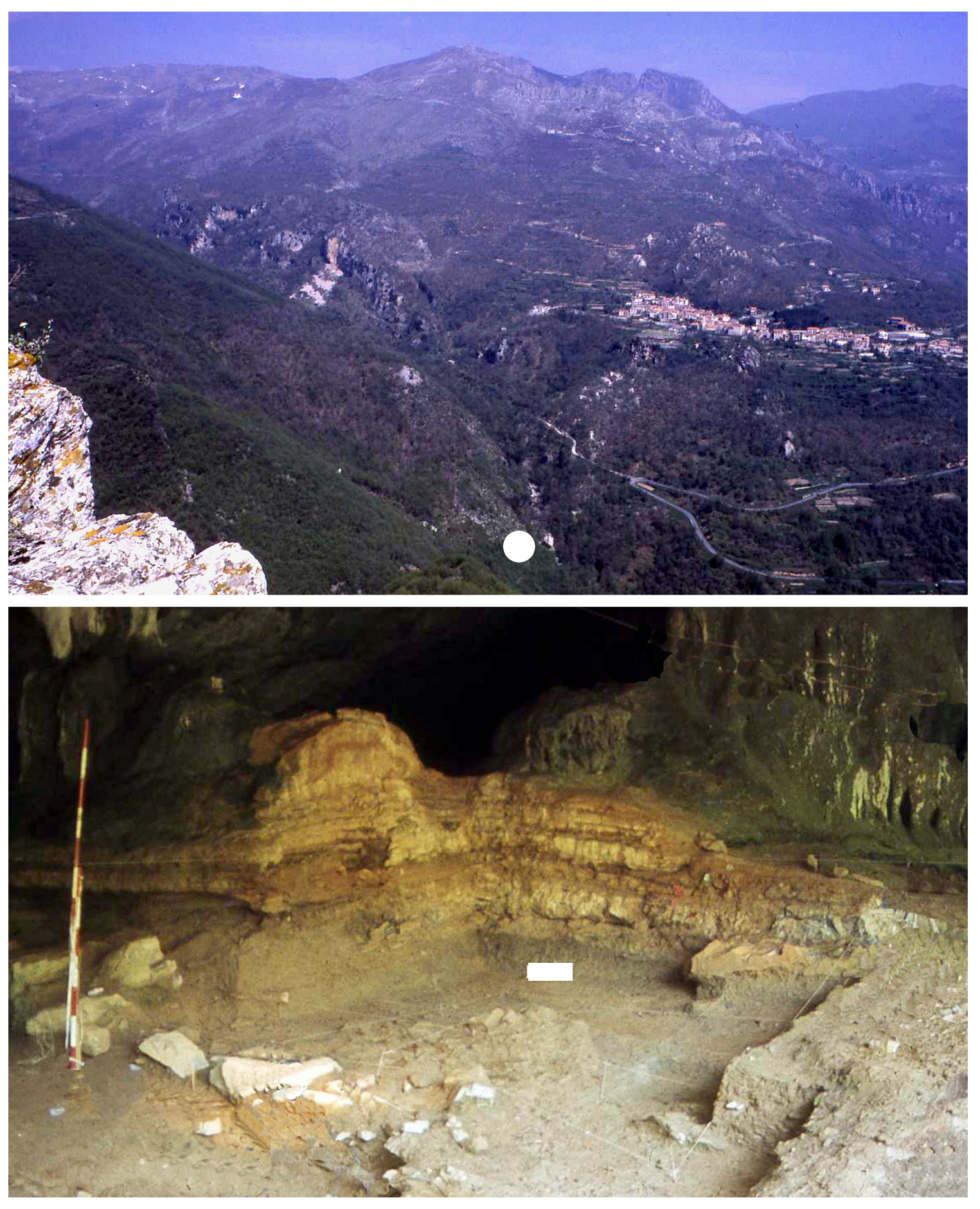
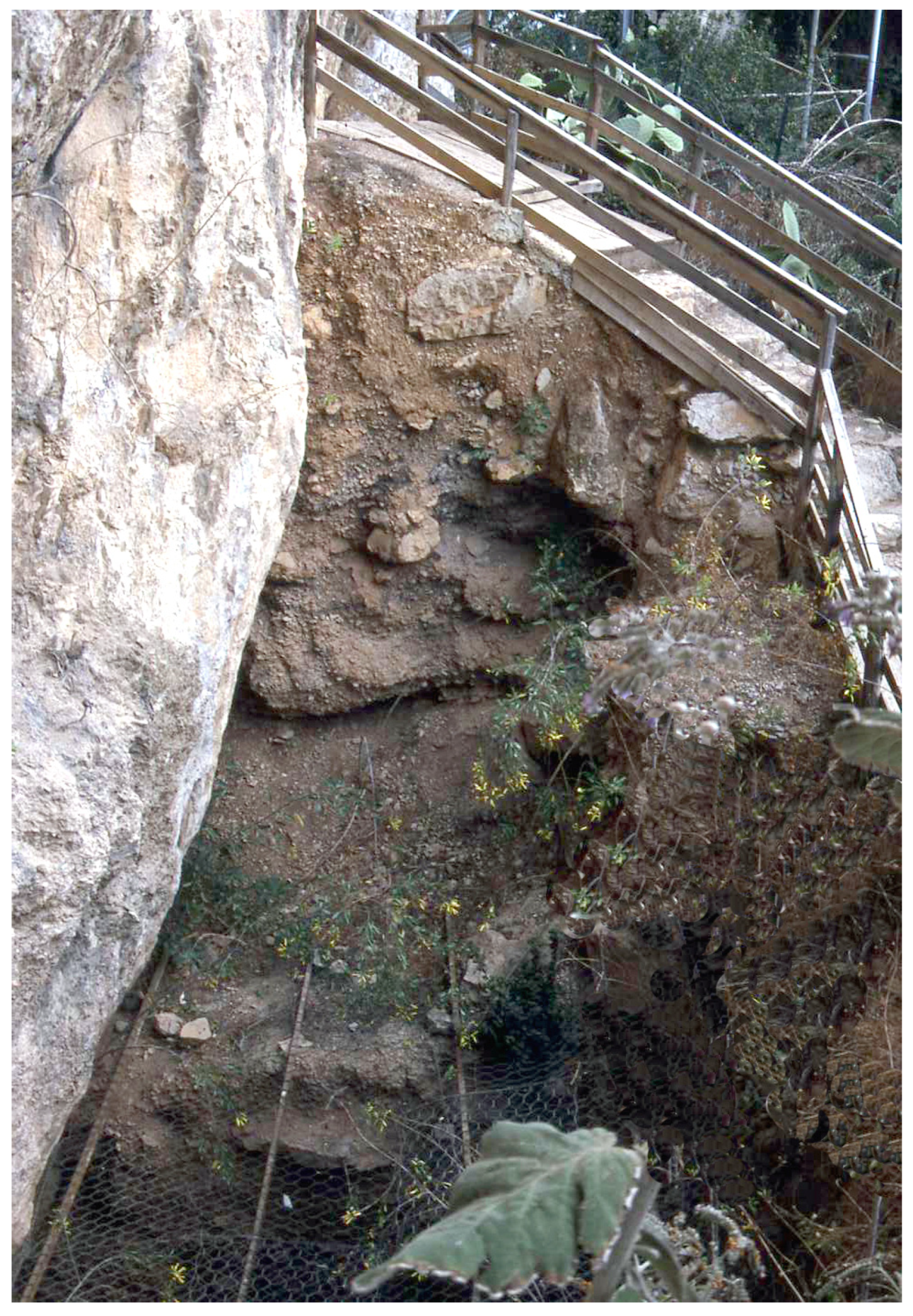
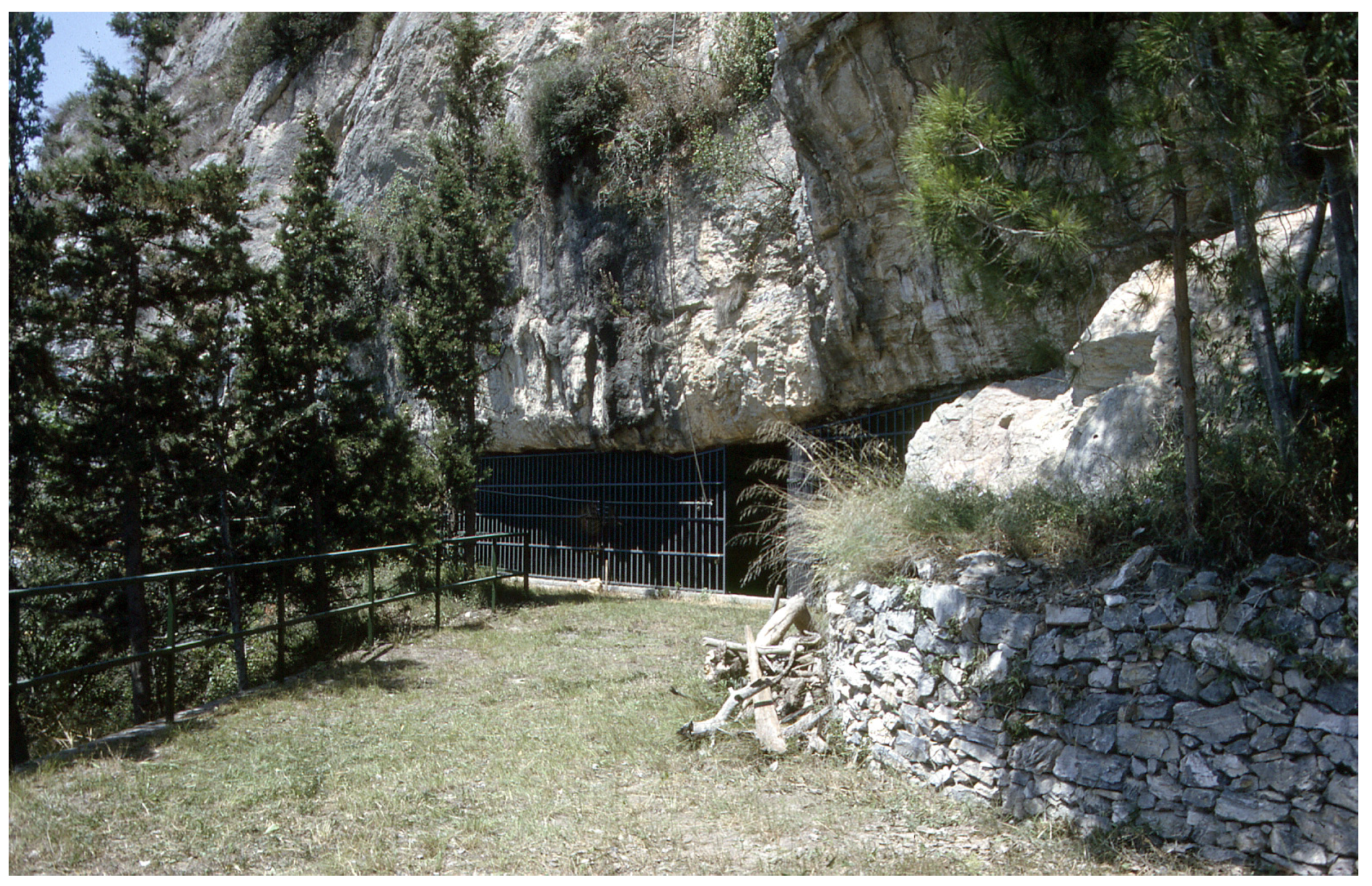
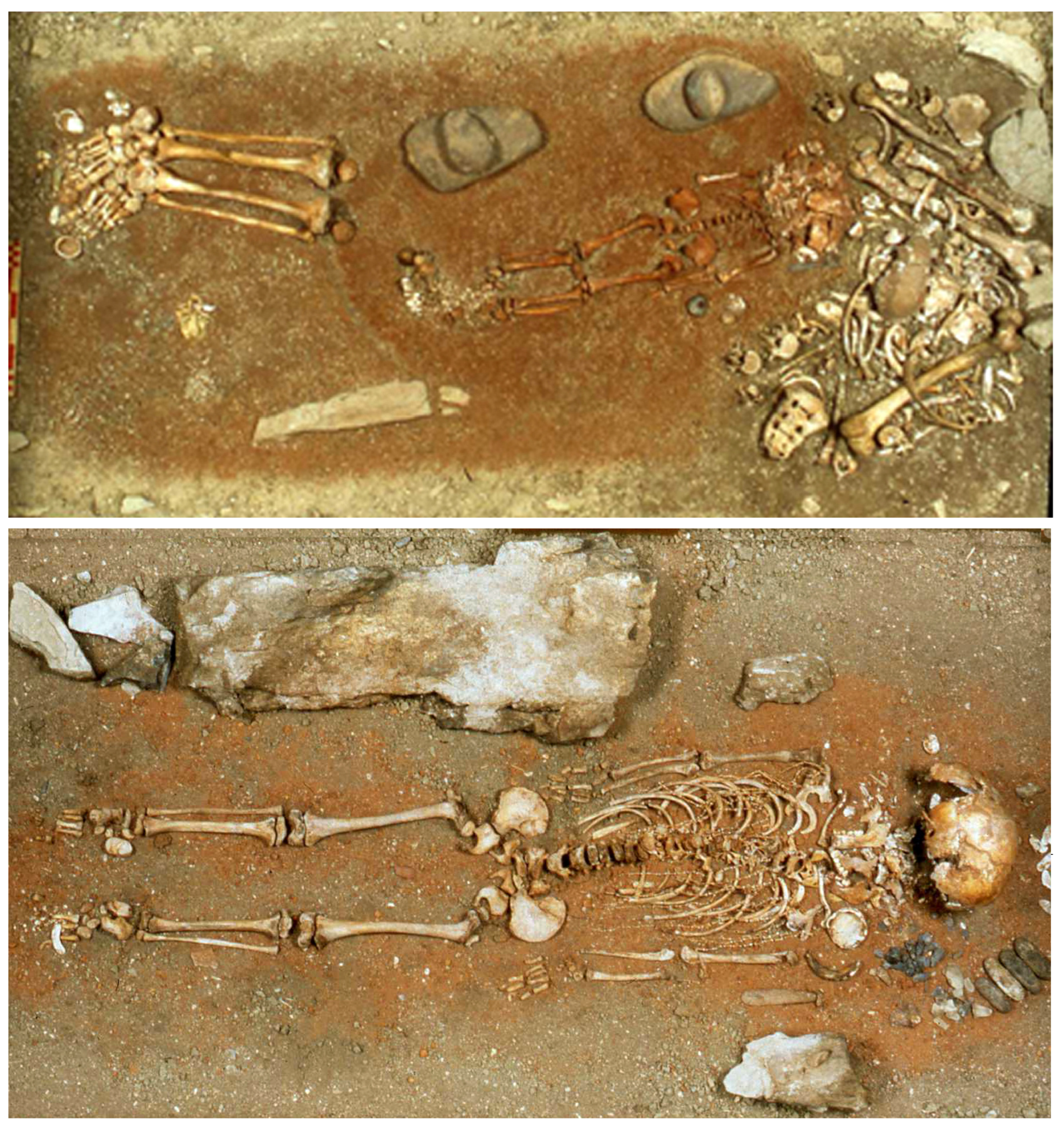
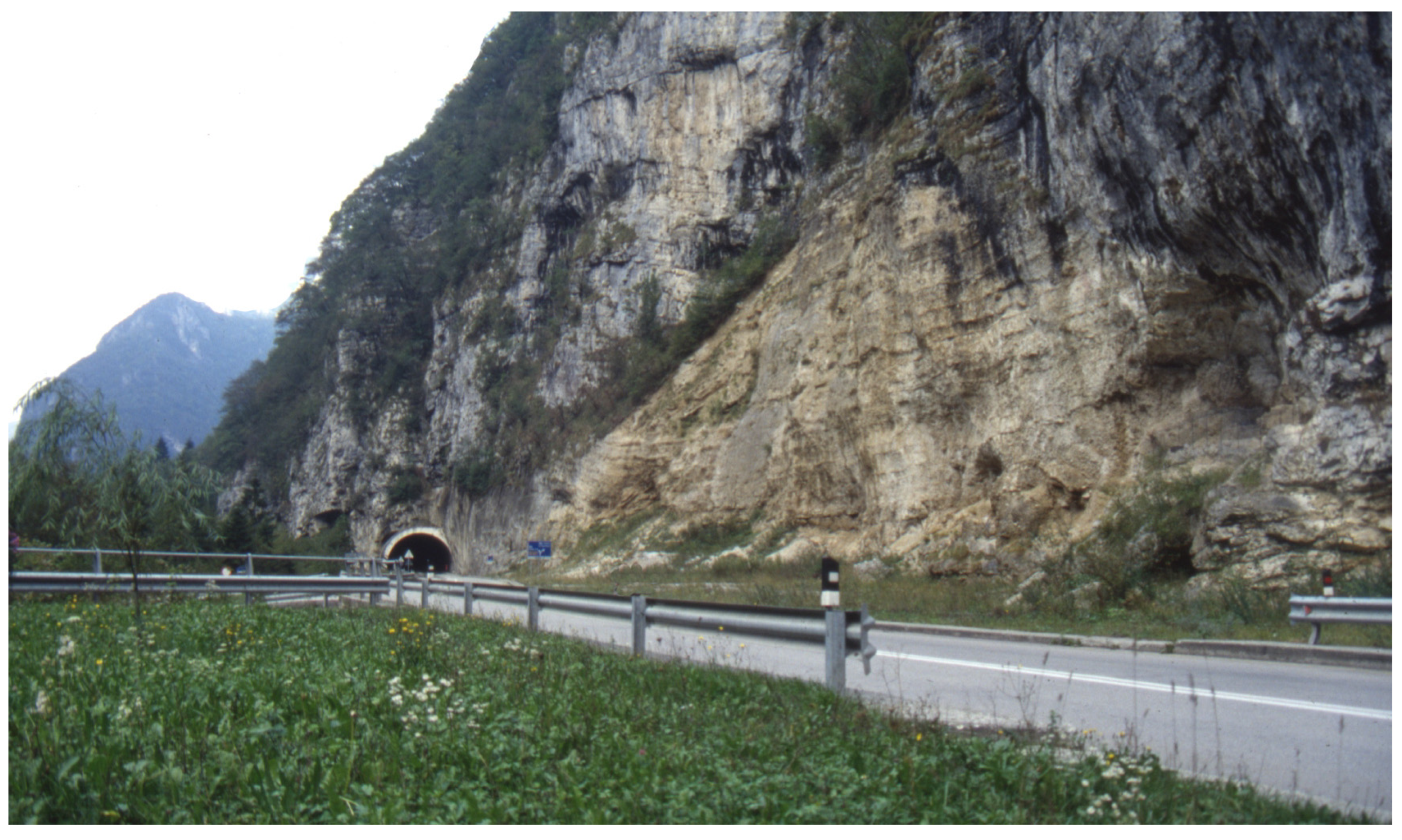
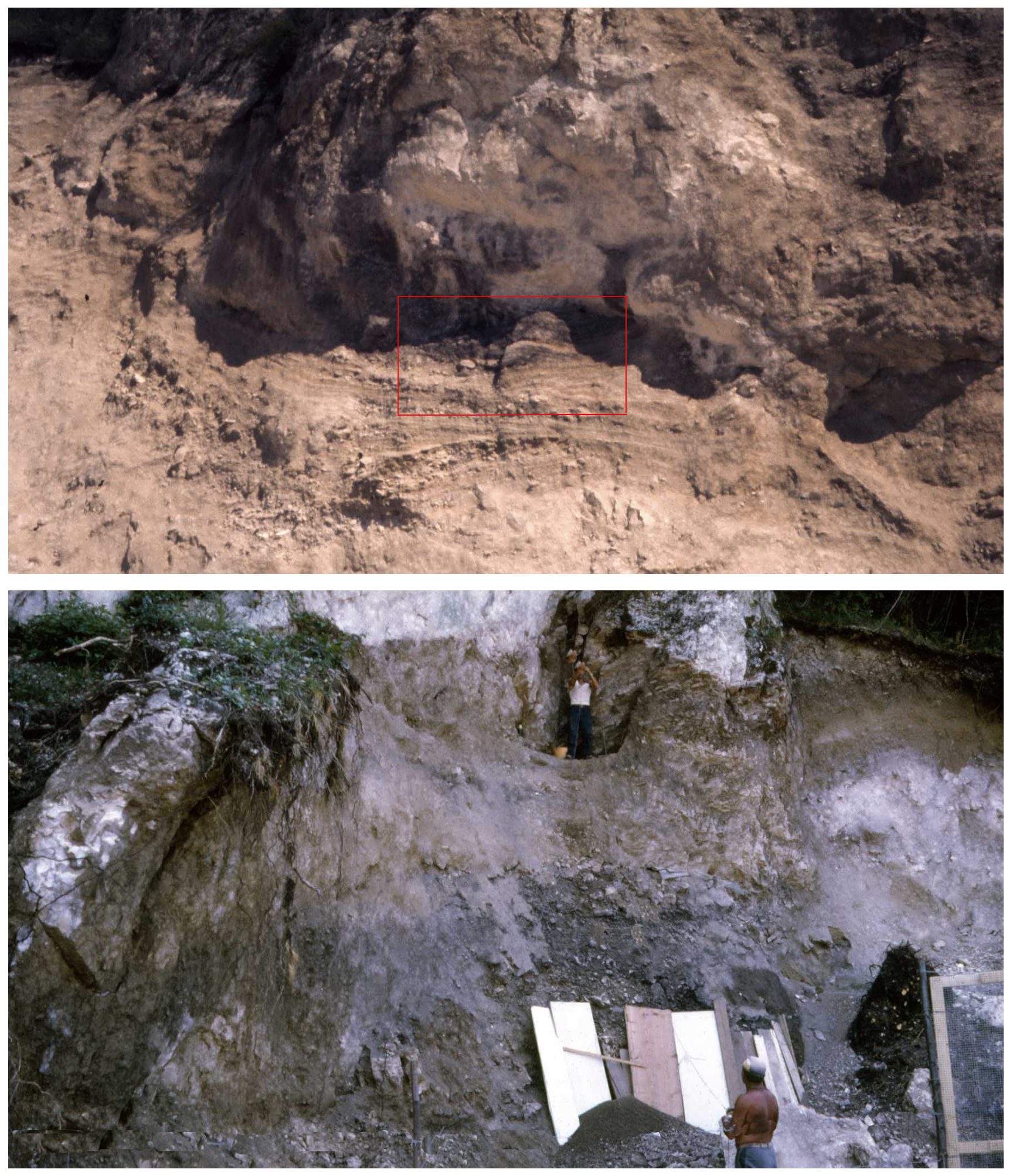

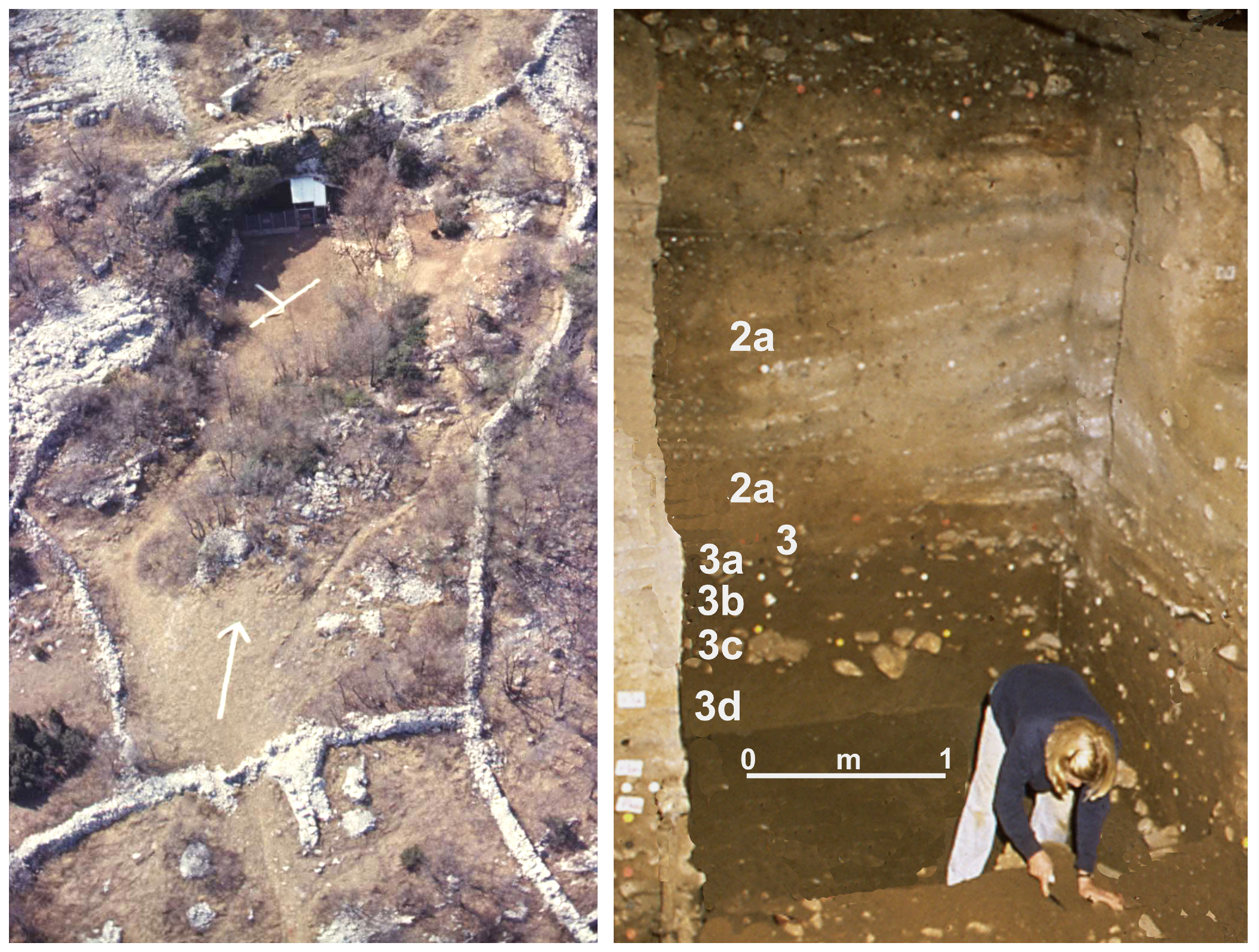


Disclaimer/Publisher’s Note: The statements, opinions and data contained in all publications are solely those of the individual author(s) and contributor(s) and not of MDPI and/or the editor(s). MDPI and/or the editor(s) disclaim responsibility for any injury to people or property resulting from any ideas, methods, instructions or products referred to in the content. |
© 2024 by the author. Licensee MDPI, Basel, Switzerland. This article is an open access article distributed under the terms and conditions of the Creative Commons Attribution (CC BY) license (https://creativecommons.org/licenses/by/4.0/).
Share and Cite
Biagi, P. The Late Palaeolithic and Mesolithic Settlement of Northern Italy: Problems and Perspectives. Quaternary 2024, 7, 2. https://doi.org/10.3390/quat7010002
Biagi P. The Late Palaeolithic and Mesolithic Settlement of Northern Italy: Problems and Perspectives. Quaternary. 2024; 7(1):2. https://doi.org/10.3390/quat7010002
Chicago/Turabian StyleBiagi, Paolo. 2024. "The Late Palaeolithic and Mesolithic Settlement of Northern Italy: Problems and Perspectives" Quaternary 7, no. 1: 2. https://doi.org/10.3390/quat7010002
APA StyleBiagi, P. (2024). The Late Palaeolithic and Mesolithic Settlement of Northern Italy: Problems and Perspectives. Quaternary, 7(1), 2. https://doi.org/10.3390/quat7010002





